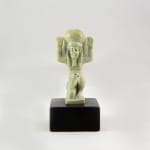Late Dynastic Faience Amulet of Shu, 750 BCE - 250 CE
Faience
5.7 x 2.9 cm
2 1/4 x 1 1/8 in
2 1/4 x 1 1/8 in
PF.5796
Further images
Shu was the primordial Egyptian god of the atmosphere and of dry winds. The name 'Shu' is probably related to the root shu meaning 'dry, empty.' Shu also seems to...
Shu was the primordial Egyptian god of the atmosphere and of dry winds. The name "Shu" is probably related to the root shu meaning "dry, empty." Shu also seems to be a personification of the sun's rays of light and the glow of the moon. In the Heliopolitan creation myth, Shu was, along with his sister Tefnut, one of the first deities created by the sun god Atum, either from his semen or from the mucus of his nostrils. Shu symbolizes dry air and the force of preservation. Tefnut symbolizes moist or corrosive air that brings about change, creating the concept of time. Shu and Tefnut were also said to be but two halves of one soul, perhaps the earliest recorded example of "soulmates." Tefnut became his consort, giving birth to the sky goddess Nut and the earth god Geb. Shu separated Geb and Nut (heaven and earth) by interposing himself between them.
Depicted in human form, often wearing upon his head an ostrich feather (the hieroglyph for his name), holding up the sky with two hands, one supporting it at the place of sunrise, and the other at the place of sunset. This faience sculpture represents Shu kneeling upon one leg, in the act of lifting up with his two hands and the sky with the solar disk in it. Although diminutive in scale, the sculptor has expertly rendered Shu in his divine human form. The only detail lacking is the ostrich plume, displaced by the solar disk. Such a sacrifice reveals the dilemma the artist faced while attempting to represent the god’s attributes while simultaneously creating a balanced and aesthetically pleasing work. Thus, although missing the feather, the artist has successfully conveyed the identity of the god while diminishing none of the artistic qualities that pervade this amulet.
Depicted in human form, often wearing upon his head an ostrich feather (the hieroglyph for his name), holding up the sky with two hands, one supporting it at the place of sunrise, and the other at the place of sunset. This faience sculpture represents Shu kneeling upon one leg, in the act of lifting up with his two hands and the sky with the solar disk in it. Although diminutive in scale, the sculptor has expertly rendered Shu in his divine human form. The only detail lacking is the ostrich plume, displaced by the solar disk. Such a sacrifice reveals the dilemma the artist faced while attempting to represent the god’s attributes while simultaneously creating a balanced and aesthetically pleasing work. Thus, although missing the feather, the artist has successfully conveyed the identity of the god while diminishing none of the artistic qualities that pervade this amulet.





